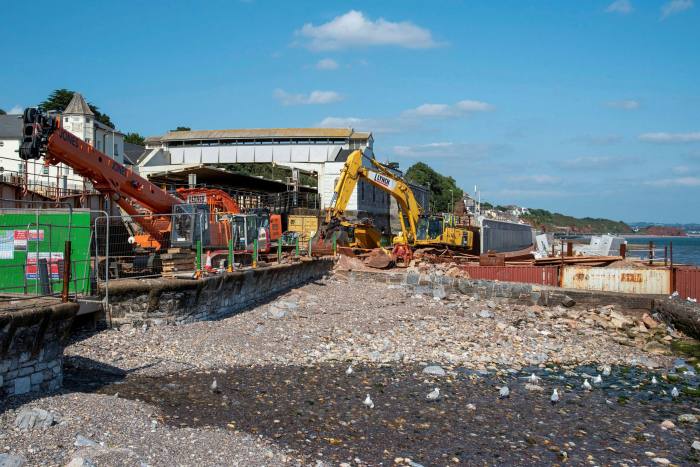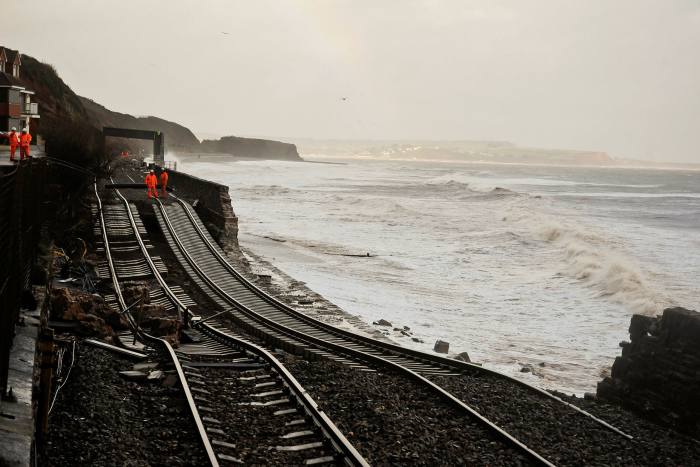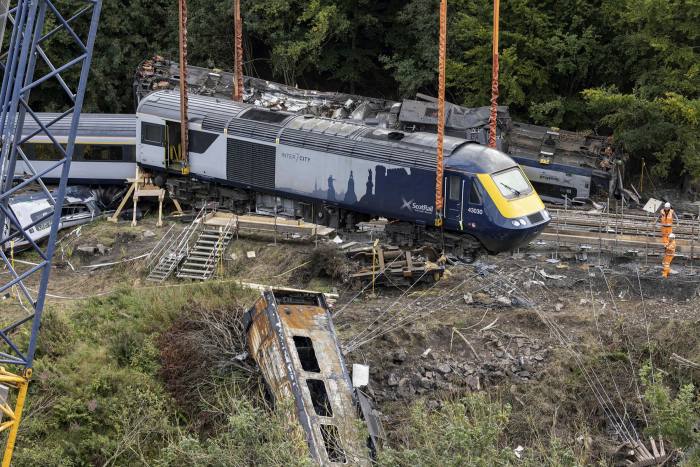Climate change’s challenge to UK’s ageing railways
In the seaside town of Dawlish in south-west England, engineers are working night and day to protect its 175-year-old railway from the modern day threat of climate change.
The waves of the English Channel crash straight into the sea wall of the line built by Isambard Kingdom Brunel, one of the leading civil engineers of the Victorian era, making this stretch of track particularly vulnerable. In 2014, part of the railway, which connects London to Penzance in Cornwall, was washed away by a heavy storm.
Seven years on, teams of structural engineers are back, waiting on the tides, as they replace the crumbling infrastructure. The new wall, made of eight-metre tall concrete slabs, is designed to protect Dawlish station and the track for the next 100 years.
The new coastal defences, built to withstand a one-metre rise in sea levels, are a stark illustration of how large parts of the UK’s railway network, which were first built in the 19th century by Victorian entrepreneurs, are under growing threat from climate change.
Britain was a pioneer of the railways, which played a key part in the industrial revolution. But age is now the enemy of the network. Trains still take the routes laid out from the 1830s onwards in contrast to continental Europe, where many of the railways were rebuilt after the second world war.
The legacy is a network that was not designed to handle rapid shifts in weather patterns. In particular, 19th century planners tried to buy as little land as possible to save money when they built the tracks, which meant narrow cuttings with steep sides that are now susceptible to flooding.
The cost of weather-related delays on the UK railways has risen steadily over the past decade, from £45m in 2009-10 to around £100m in 2019-20, according to Network Rail, the state-owned infrastructure operator.
Extreme weather can damage the tracks, the many ageing bridges and tunnels and the network of tens of thousands of cuttings and embankments.
“The pattern is of individual events just getting more frequent and more intensive,” said Martin Frobisher, Network Rail’s safety and engineering director. “We break weather records every year . . . and each of those extremes of weather has an impact on the railway.”
Yet Network Rail faces plenty of uncertainty about future state funding: ministers have pushed through spending cuts that affected some upgrades and proposed new rail links, especially in northern England.
Tony Travers, a transport expert at the London School of Economics, warned that to prepare the network for climate change would “cost a substantial amount of money,” adding: “It is not at all clear that is available.”
Under its existing five-year funding settlement that runs until 2024, Network Rail plans to spend £500m on mitigating extreme weather events. Frobisher said it planned to allocate more cash to maintaining earthworks and drainage over the following five years.
It is financially incentivised to tackle climate change as it has to compensate train operators for weather disruption. When the line at Dawlish was badly damaged in 2014, Network Rail paid out up to £16m in compensation.
Rail executives have warned the problems facing the network will only get worse in the coming decades as severe weather events become more common.
Network Rail concluded that the “impact of extreme weather and climate change [was] accelerating faster than its planning assumptions,” according to a 2018 report by the National Audit Office, the government spending watchdog.
“This is a risk for the rail industry going forward, it is a risk the industry is aware of, and when you know about it you can start doing things about it,” said Malcolm Brown, chief executive of Angel Trains, the rolling stock leasing company, and chair of the cross-industry lobby group Sustainable Rail Executive.
Network Rail has turned to new technology to monitor tracks and other infrastructure, using drones and artificial intelligence to sift through mountains of data collected by cameras mounted on trains. It is also working with the Met Office on trying to better predict which sections of track could be at risk during storms.
“We see a shift from traditional maintenance to predictive maintenance programmes that rely more on digital technologies,” said Nicola Sandri, global transport infrastructure leader at McKinsey.
Rail safety experts have warned that the UK is not immune to the catastrophic floods in Germany and Belgium last summer, which killed nearly 200 people and caused an estimated €1.3bn in damage to the railways. The floods damaged 180 level crossings, more than 50 bridges and over 1,000 signal and electrical masts.
Three people were killed after a train derailed in north-east Scotland in August 2020 following heavy rain, the UK’s first fatal rail crash in more than a decade.
Although the industry is still waiting for the full findings on the crash from accident investigators, a climate change report by the Rail Safety and Standards Board said it seemed “clear that the changing climate and the occurrence of extreme weather [was] a key root cause.”
Climate Capital

Where climate change meets business, markets and politics. Explore the FT’s coverage here.
Are you curious about the FT’s environmental sustainability commitments? Find out more about our science-based targets here
Newer projects are designed with resilience built in. Engineers on HS2, the new high-speed railway being built between London, Birmingham and ultimately Manchester, are incorporating what are dubbed sustainable drainage systems using landscaping techniques along the tracks. These are meant to ensure services can run even during a one-in-1,000 year flood event.
But the age of most of Britain’s rail network makes the cost of weatherproofing all the track prohibitive and will mean some difficult decisions would be needed, according to George Davies, director of sustainable development at the RSSB. Ultimately, the safest option would be to cancel services during extreme weather events, he added.
“I don’t believe it is viable and it is almost certainly unaffordable to design our railway to be 100 per cent climate resilient, so there is going to be a trade-off needed,” said Davies. “I am not sure yet the industry has a particularly good idea of what might be acceptable.”


